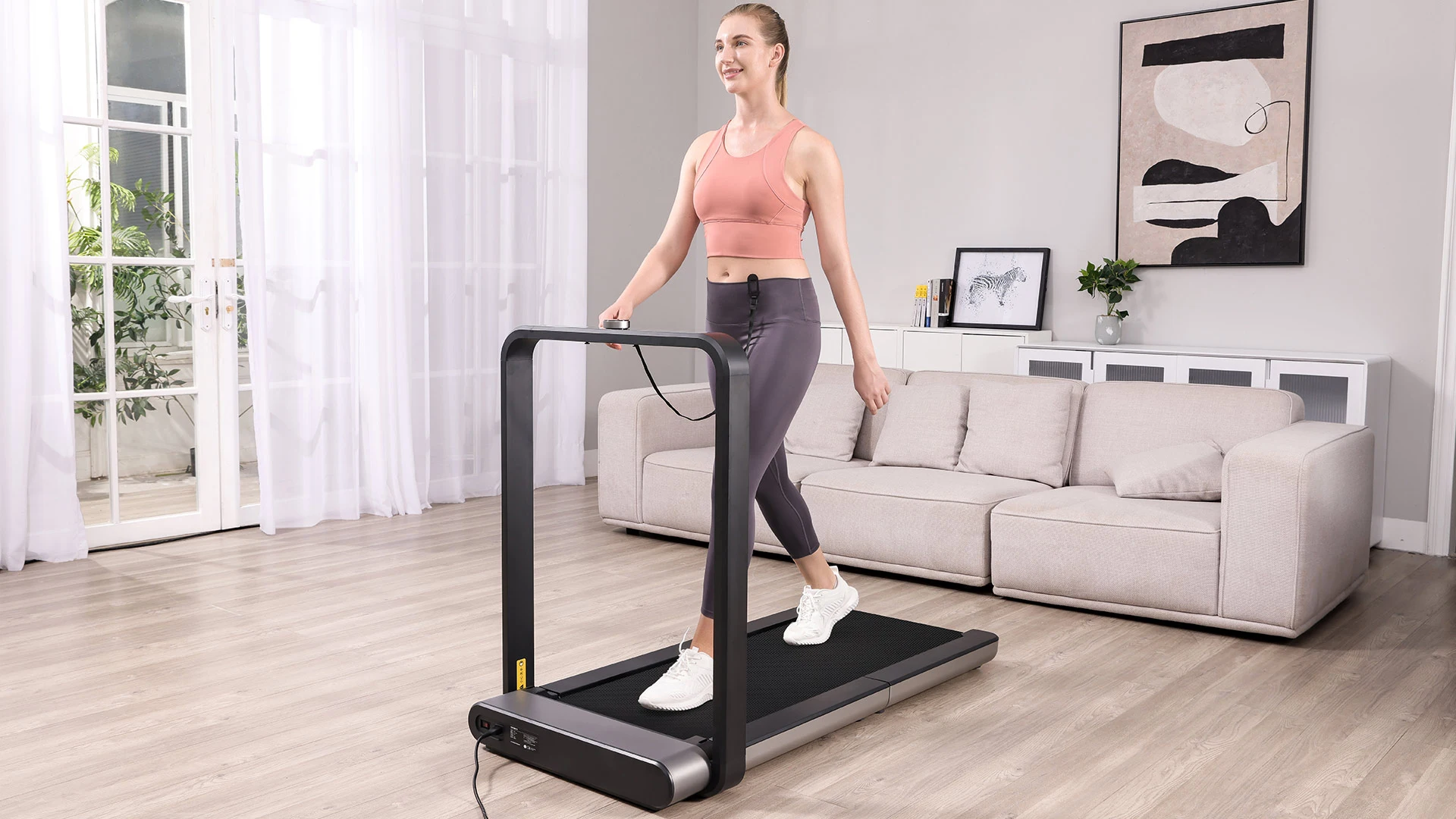
How Many Steps Should I Walk Per Day? A Complete Guide
Table of Contents
In today’s fast-paced world, our daily routines have become more sedentary than ever. Whether it's work, school, or just life in general, many of us find ourselves glued to our screens or stuck behind a desk for long hours. This lifestyle can lead to a variety of health issues, from poor posture to weight gain and low energy levels. This is why you might be wondering: How many steps should I walk a day?
Walking is an incredibly accessible and effective way to break free from a sedentary routine and improve both physical and mental health. In this complete guide, we’ll not only explore the ideal daily step count for general health, weight loss, and fitness but also provide tips, benefits, and answers to common questions about walking.

Why Walking Should Be Part Of Your Daily Routine
Walking is not just a means of getting from point A to point B. It is a powerful, low-impact form of exercise that can drastically improve your overall health.
Let’s take a closer look at the physical and emotional advantages of incorporating more steps into your daily life.
1. Weight Management
Regular walking can be an essential part of your weight management routine. Whether you aim to maintain or lose weight, walking helps burn calories and boost metabolism. In fact, increasing your step count can be a straightforward strategy for weight loss.
Try adding a few extra steps each day, aiming for 12,000 or even 15,000 steps for faster calorie burn. Walking works best when paired with healthy eating habits. Consider tracking what you eat alongside your steps to stay on top of your weight management goals.
If you want to understand how this works on a deeper level, you may want to read about the importance of creating a calorie deficit for losing weight and how it relates to your walking routine.
2. Better Joint Health
Unlike high-impact exercises, walking is known to be gentle on your joints. This helps you reduce the risk of arthritis-related health problems while improving joint flexibility.
You can aim to walk at least 30 minutes a day to keep your joints in good condition and do gentle stretches before and after your walks to reduce stiffness.
3. Improved Cardiovascular Health
Walking is a great way to improve cardiovascular health. It can help lower blood pressure, reduce cholesterol, and enhance circulation. The consistent increase in heart rate during regular walks can reduce the risk of heart disease.
Consider adding cycling or swimming to your routine, along with walking, to significantly improve heart health.
Interested in how this impacts your energy? Explore our article on active energy vs resting energy to understand how different activities contribute to your daily energy expenditure.
4. Better Mental Well-Being
Walking is a natural stress reliever. As you walk, your body releases endorphins, which are hormones that help boost your mood and reduce feelings of anxiety. A simple walk can clear your mind and improve your emotional state.
If possible, walk in a park or natural setting. Being surrounded by nature has additional mental health benefits, such as reducing stress and improving focus.
5. Improved Lung Function
You promote better oxygen intake and deeper breathing. This better your lung capacity and function.
6. Increased Energy Levels
Feeling sluggish or tired? Walking can combat fatigue. Regular walking promotes better blood circulation, helping you feel more energized and productive throughout the day.
For a deeper dive into how walking impacts calorie expenditure, check out our detailed article on calorie expenditure.

How Many Steps Should You Take A Day For General Health?
If you have ever come across the most common question, “How many steps are recommended per day?” before joining the walking journey. Here is the global answer: 10,000 steps per day.
This has become a widely recognized benchmark for maintaining a healthy lifestyle. But where did this number come from, and is it the right goal for everyone?
1. The Pros
- Supports Heart Health:
Walking 10,000 steps a day is an excellent way to improve cardiovascular health. It increases your heart rate, promotes healthy circulation, and strengthens your heart, reducing your risk of heart disease.
You can even burn more calories while walking 10k steps a day. If you’re interested, you can explore our guide on how many calories 10,000 steps burns to track your progress.
- Boosts Mental Health:
Regular walking has been shown to decrease symptoms of anxiety and depression. As you walk, your body releases endorphins, also known as the "feel-good" hormones, which can boost your mood and reduce stress.
- Improves Overall Fitness:
Reaching 10,000 steps every day can improve your overall stamina and endurance. It’s a manageable and consistent way to increase your physical activity, contributing to your long-term fitness goals.
2. The Cons
- Not One-Size-Fits-All:
For those who are just starting their fitness journey or have a sedentary lifestyle, the goal of 10,000 steps can feel overwhelming. It may take some time to gradually increase your step count, and reaching this target may seem daunting.
- May Not Be Realistic for Busy Schedules:
If you have a packed daily schedule, finding time to walk 10,000 steps can be a challenge. This may lead to feeling frustrated or unmotivated if you’re unable to reach this target consistently.

3. My Tips For Reaching 10,000 Steps
Walking 10,000 steps each day might seem daunting if you’re not accustomed to a high step count. That’s why we’ve put together some tips to help you gradually increase your daily step count:
- Start Slowly:
If you're not used to walking a lot, don’t aim for 10,000 steps right away. Start by tracking your current step count and aim to increase it by 500-1,000 steps each day. Gradually build up until you reach the 10,000-step target.
After your body has fully adapted to this target, you can incorporate jogging and running into your routine to burn more calories. You can check out our guide on the jogging calories burned and the calories burned by running to understand how to calculate and keep track of your progress.
- Break It Up:
Walking 10,000 steps at once might feel like too much. Instead, break it up into smaller walking sessions. You can take a 10-minute walk during your lunch break, walk after dinner, or use part of your commute to add steps.
- Track Your Steps:
Use a pedometer, smartphone app, or fitness tracker to monitor your progress. This will help you stay on track and provide motivation as you see how much progress you’re making.
- Make Walking A Habit:
Incorporate walking into your daily routine. It could be as simple as walking to the store, parking farther away, or walking around your home or office while you take calls.
How Many Steps Per Day To Take For Weight Loss?
For weight loss, you’ll likely need to aim for more than 10,000 steps. 12,000 to 15,000 steps per day is ideal for burning more calories and losing weight effectively.
1. The Pros
- Increases Calorie Burn:
Walking more steps burns more calories, helping you create the calorie deficit necessary for weight loss. By aiming for 12,000 to 15,000 steps a day, you'll burn significantly more than the 10,000-step goal.
- Sustains Fat Loss:
Longer walks or higher step counts encourage the body to burn fat for energy, especially when combined with a balanced diet. This helps support long-term weight loss rather than just temporary water loss.
- No Intense Exercise Required:
Unlike running or high-intensity workouts, walking at a brisk pace for longer periods can still be an effective weight loss strategy without requiring you to push your body to extremes.
- Improves Metabolism:
Walking a higher number of steps helps kickstart your metabolism and encourages efficient energy use, supporting weight management in the long run.
You might want to learn more about how walking compares to other forms of exercise for weight loss. Consider exploring our comprehensive article about the stepper vs walking pad, stairmaster vs stepper, or stepper vs elliptical, depending on your preferences and goals.
You can also compare walking to other cardio exercises, like the Stairmaster, to find which is more effective for your fitness goals.
.webp)
2. The Cons
- Time-Consuming:
To achieve 12,000 to 15,000 steps, you'll need to invest more time. Walking for this long (roughly 2 to 3 hours, depending on your pace) may be difficult for those with busy schedules.
- May Be Too Much For Some People:
If you’re not used to walking, or have certain medical conditions or injuries, aiming for 15,000 steps may be too demanding. It's important to listen to your body and consult a healthcare provider if needed.
- Risk Of Overdoing It:
Walking too much without proper rest can lead to overuse injuries, especially in the joints and muscles. If you push yourself too hard, you risk exhausting your body rather than achieving the health benefits.
3. Tips For Weight Loss
- Incorporate Brisk Walking:
To make the most of your walk, try walking at a brisk pace. Brisk walking increases calorie burn and helps you reach your weight loss goals faster.
- Add Intervals:
If you’re comfortable with walking 12,000-15,000 steps, increase your calorie burn by incorporating interval walking. Alternate between walking briskly and at a slower pace to challenge your body and burn more calories.
- Combine Walking With A Healthy Diet:
For weight loss, walking needs to be combined with a calorie-controlled diet. Focus on whole foods, lean proteins, and healthy fats to maximize your weight loss.
- Stay Consistent:
Make walking a part of your daily routine. The more consistent you are, the more sustainable your weight loss efforts will be over time.
- Use A Fitness Tracker:
Use a fitness tracker to monitor your progress. Not only will it help you keep track of your steps, but it will also show how many calories should you burn a day, providing valuable insight into your weight loss journey.
Plus, by using a fitness tracket, you can also distinguish the difference the active calories vs total calories while walking or incorporating walking with other forms of exercise.
How Many Steps Should You Take To Improve Your Fitness?
Maybe your primary goal isn’t to lose weight but to improve your fitness. For general fitness, aiming for 7,000 to 8,000 steps per day is a great place to start. This is enough to increase your cardiovascular health and stamina without being overwhelming.
1. The Pros
- Achievable For Most People:
Aiming for 7,000 to 8,000 steps is a more realistic goal for those who are just starting their fitness journey or have a busy schedule. It provides a manageable target that still offers health benefits.
- Supports Heart And Lung Health:
Even though it’s fewer steps, walking 7,000 to 8,000 steps a day still improves heart health and lung function, which are critical to overall well-being.
- Increases Daily Activity:
Even a moderate number of steps can reduce the sedentary behavior that’s become so common in our daily lives. It encourages movement, which is vital for both mental and physical health.
- Sustainable Long-Term:
This step count is sustainable over the long term, making it an easy way to stay active for life without overburdening yourself.

2. The Cons
- May Not Be Enough For Serious Weight Loss:
While 7,000 to 8,000 steps a day is great for general health, it might not be enough to drive significant weight loss for individuals who need a larger calorie deficit.
- Not Intense Enough For High-Level Fitness Goals:
For athletes or individuals with more intense fitness goals, this level of activity may not be sufficient to improve performance or build muscle mass.
- Limited Muscle Building:
Walking does not offer the same muscle-building benefits as activities like weight lifting or high-intensity interval training (HIIT).
3. Tips For Fitness Improvement
- Incorporate Strength Training:
While walking is great for cardiovascular fitness, adding strength training exercises can complement your walking routine and help you build muscle, improve strength, and boost metabolism.
- Add Intervals for Increased Intensity:
Incorporate short bursts of brisk walking or even light jogging during your walks. This will challenge your cardiovascular system and improve your overall fitness level.
- Track Your Progress:
Use a fitness tracker or app to monitor your steps, distance, and overall activity levels. Tracking your progress will help you stay motivated and provide a sense of accomplishment.
- Stretch After Walks:
Incorporate flexibility exercises or stretching routines to keep your muscles supple and reduce the risk of injury.
- Mix Up Your Routine:
To avoid monotony and keep things interesting, vary your walking routes or include different terrains (like hills or trails). This will help challenge your body in new ways.
Tips To Help You Incorporate More Walking Into Your Day
Incorporating walking into your daily routine doesn’t have to be a daunting task. With a few thoughtful changes and simple strategies, you can easily increase your step count without overwhelming yourself.
Understanding how calorie burn fits into your fitness journey can also help guide you toward your goal. For more on this, read about the myths and facts of the calories in vs. calories out concept.
Here are some practical tips to help you seamlessly integrate more walking into your day:
1. Park Further Away
A small adjustment like parking farther from your destination can make a big difference in your daily steps.
Whether you're heading to work, running errands, or going out for a meal, parking a little farther away from the entrance gives you extra steps without impacting your schedule. It's an easy way to add some movement to your day without much effort.
2. Walk To Work Or Take Public Transportation
If you live within walking distance of your workplace, why not consider walking to work? It's a simple way to get in some daily exercise, save on transportation costs, and start your day with some fresh air.
If walking to work isn’t feasible, consider getting off public transportation one or two stops earlier and walking the rest of the way. It’s an easy way to add steps to your daily commute without disrupting your routine.

3. Invest In A Standing Desk
If you have a desk job and find yourself sitting for long periods, consider using a standing desk. Standing encourages more movement throughout the day and can make it easier to take breaks and walk around.
Additionally, some standing desks offer adjustable height settings, which allow you to switch between sitting and standing, making it easier to move more frequently. This can help reduce the harmful effects of sitting for too long and get your body moving throughout the day.
4. Take Short Walking Breaks
Another easy way to increase your step count is to take short walking breaks throughout the day. If you’re working at a desk or on a project, set a timer to remind yourself to get up and walk for five minutes every hour.
These mini-breaks help you stay focused and energized while providing much-needed movement to reduce stiffness and improve circulation.
5. Make Walking Part Of Your Lunch Break
Instead of sitting down for your entire lunch break, why not take a short walk after eating? You could walk around your office building, take a stroll around the block, or simply get outside for some fresh air.
Not only does this increase your daily steps, but it also helps refresh your mind and gives you a burst of energy for the rest of the day. Plus, walking after meals can help with digestion and regulate blood sugar levels.
6. Walk With Friends Or Family
Walking doesn’t have to be a solo activity. Invite a friend, family member, or coworker to join you on your walks. Socializing while walking is a great way to stay motivated and enjoy the experience.
Whether you’re catching up with a loved one or simply enjoying the company of someone else, walking with a buddy can make the process more enjoyable and help keep you consistent.
7. Make It A Habit
Turning walking into a daily habit requires consistency. Start by setting a specific time each day for your walk, whether it’s first thing in the morning, during lunch, or after work.
The more you make it a regular part of your routine, the more natural it will feel. It’s also important to rest properly after walking. Resting gives your body an appropriate time to recharge and recover after moving constantly. You may want to check out our article about how many calories do you burn doing nothing to actually understand the importance of resting.
Incorporating more walking into your daily routine doesn’t have to be complicated. Even small changes can add up! Walking can be a key component of your overall calorie burn. Combine your walking routine with healthy eating habits to create the right calorie restriction for weight loss.
For those looking to enhance their walking sessions, you can also consider walking on a treadmill. Curious about the best times to walk on a treadmill for weight loss? Check out our post on tips for walking on a treadmill to lose weight for practical advice.

FAQs
1. How many steps a day are considered active?
Generally, walking 7,000 to 10,000 steps a day is considered active. This range helps promote cardiovascular health, maintain a healthy weight, and increase energy levels. If you are just starting out, aim for 5,000 to 6,000 steps and gradually increase your step count over time.
For more on how your body burns calories, read our article on active vs. resting calories.
2. How many steps should you take a day to lose 2 pounds a week?
To lose 2 pounds a week, you typically need a calorie deficit of about 7,000 calories. Walking 12,000 to 15,000 steps a day, combined with a healthy, calorie-controlled diet, can help you achieve this goal. However, the exact number may vary depending on your walking speed, intensity, and other factors like metabolism.
3. How many steps per day should I walk by age?
The ideal number of steps a day can vary by age, but here are general guidelines:
- Children and Teens (6-17 years): Around 12,000 to 15,000 steps a day is ideal for this age group to maintain a healthy weight and promote physical activity.
- Adults (18-64 years): Aim for at least 10,000 steps a day for general health and fitness, but 7,000-8,000 steps can be sufficient for those starting out or with less active lifestyles.
- Older Adults (65+ years): Around 6,000 to 8,000 steps a day is a good target, as older adults may need more rest and recovery time. Adjust based on individual health needs and mobility.
4. How many steps a day to stay healthy?
To stay healthy, 10,000 steps a day is commonly recommended. This helps improve cardiovascular health, maintain a healthy weight, and boost mental well-being.
However, even a lower number of steps, such as 7,000 steps, can provide significant health benefits when done consistently.
5. Can walking help me lose weight?
Yes! Walking is a great low-impact exercise that burns calories and can support weight loss. To maximize its effectiveness, combine your walking routine with a healthy, calorie-controlled diet. For faster results, consider walking at a brisk pace or adding intensity with uphill walks or interval training.
How long does it take to walk 10,000 steps?
Wrapping It Up
The question, “How many steps should I walk per day?” is a valuable starting point for anyone wanting to live a healthier and more active life.
No matter your fitness goals, walking is a great way to improve your health and well-being. Whether you're aiming for 7,000 to 8,000 steps for fitness, 10,000 steps for general health, or 12,000 to 15,000 steps for weight loss, walking is a simple yet powerful way to support a healthier lifestyle. As you get used to walking more, consider integrating tools like fitness trackers to help you stay on track.
If you’re also interested in tracking how much you should walk to lose weight, check out our calculator for how many steps you should take to lose weight, which can help you set a more personalized goal. You may consider reading about how walking can help you burn calories while sitting at work in our guide.
All you need is a little strategic planning, and you’re ready to increase your average steps per day.
.svg)







